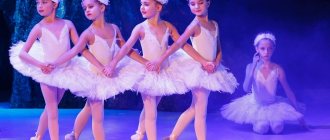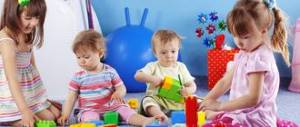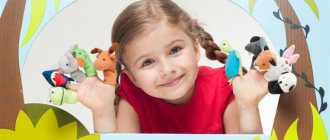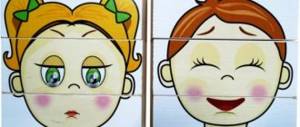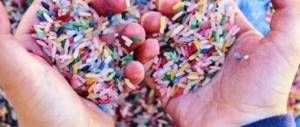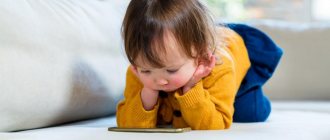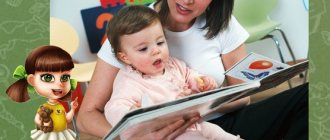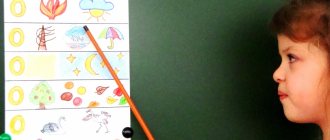Reflection in educational activities in accordance with the Federal State Educational Standard for Education.
Reflection should be built in a playful form, then it constitutes the content of specially organized activities.
Everything that is done in a lesson on organizing reflective activity is not an end in itself, but preparation in conscious internal reflection for the development of very important qualities of a modern personality.
The process of reflection must be multifaceted, since the assessment must be carried out not only by the individual herself, but also by the people around her.
Reflection allows you to accustom a child to self-control, self-esteem, self-regulation and the formation of universal educational actions.
Communicative methods of reflection:
"Spark of Communication"
(Children in a circle, hugging their shoulders, say what was most interesting);
"Heart"
(Children pass a symbolic heart in a circle and say: “Today I was pleased...”, “Today I was saddened...”);
"Present"
(The child gives medals (flowers) of three different colors to those whom he sees fit. For example, blue - to the most polite in communication, green - to the most flexible (yielding), orange - to the most modest. Who got the largest bouquet? Why do you think ?)
Educational activities
represents a “shuttle” movement of alternating activities – objective and reflexive.
Everything that is done in a lesson on organizing reflective activity is not an end in itself, but preparation in conscious internal reflection for the development of very important qualities of a modern personality.
To all that has been said, we can summarize: reflection is a joint activity of children and the teacher, which makes it possible to improve organized educational activities in older preschool age, focusing on the personality of each child. And in order for such reflection to take place effectively, it is necessary to begin to carry it out in early age groups.
It’s not for nothing that they say - everything is in our hands.
As long as we ask ourselves questions, we develop. As soon as the teacher begins to be satisfied with what has been achieved, his professional growth stops. Of course, reflection is a prerequisite for the self-development of not only children, but also the teacher.
Important to remember!
If a person does not reflect, does not carry out self-analysis of his activities and the activities of his students, their results, he does not fulfill the role of a subject of the educational process;
Lack of reflection is an indicator of focus only on the process of activity, and not on the changes that occur in human development.
PROFESSIONAL REFLECTION OF A TEACHER—
Research, study your own achievements and “failures” to “polish” your professional skills, comprehend your professional positions, your values, principles;
Techniques for organizing reflection in children's association classes
"Train" . On the desk in front of each child there are two tokens: one with a smiling face, the other with a sad one. On the board there is a train with carriages on which the stages of the lesson are indicated. Children are asked to put the “cheerful face” in the trailer that indicates the task that you were interested in doing, and the “sad face” in the one that symbolizes the task that did not seem interesting. Only one token may be used at the child's discretion. Reflection of mood and emotional state is carried out at the beginning of an educational session/lesson in order to establish emotional contact with the group and at the end of the activity. This reflection contributes to the formation of a favorable microclimate in the classroom. The student tunes in to the lesson and shows genuine interest in the next stages of the lesson. Muscle tension is relieved before the lesson and tension is completely relieved at the end of the lesson. Here the health-saving function of reflection is implemented. Cards with images of faces, color images of moods, emotional and artistic design (painting, musical fragment), and computer programs are used. You can invite children to compare their mood with the image of some animal (plant, flower) and draw it, you can explain it in words.
Please note => Unit code service by okei service
Development of reflection in preschool children
Reflection can be carried out
not only at the end of the lesson, as is commonly believed, but also
at any stage
.
It is aimed at realizing the path traveled, at collecting into a common treasury what was noticed, thoughtfully, and understood by everyone. Her goal is not just to leave the lesson with a fixed result, but to build a chain of meaning, to compare her methods and methods with others. In fact, reflection is not just rewinding, as in a VCR, the events of the past, since there are different types of reflection
. When interacting with children, the teacher uses, depending on the circumstances, one of the types of educational reflection, reflecting four spheres of human essence:
Please note => Who belongs to low-income families in 2019 in Perm
Development of reflection of preschool teachers using the art therapy method
Bibliographic description:
Yakimova, M. S. Development of reflection of preschool teachers using the art therapy method / M. S. Yakimova. — Text: direct // Questions of preschool pedagogy. — 2020. — No. 5 (32). — P. 56-59. — URL: https://moluch.ru/th/1/archive/166/5154/ (date of access: 10.10.2020).
The article determines the importance of developing the ability to reflect in preschool teachers and gives a definition of reflection. Art therapy is considered as a method of psychological work aimed at developing reflection, and the advantages of this method are described. A description of a specific art therapeutic exercise is provided that can be used at workshops or trainings with preschool teachers.
Key words: reflection, art therapy, art therapeutic exercise “My Planet”.
In the conditions of modern society, with its high demands on the professional suitability and competence of specialists from various educational institutions, the mental state of preschool teachers can cause serious concern [9].
The need to interact with various participants in the educational process (children, their parents, fellow teachers, preschool administration), the implementation of educational activities themselves, the need for constant professional development and self-improvement, the desire to creatively approach their duties - are often associated with serious intellectual and emotional stress for members of the teaching staff.
E.M. Semyonova believes that teachers may experience aggressiveness, increased irritability to insignificant, minor events or, conversely, a feeling of unconscious concern, anxiety, and general apathy. All this can lead to emotional burnout of the teacher, which cannot but affect the results of his activities [6]. To maintain their own mental health, it is important for preschool teachers to be able to monitor their emotional states, feelings, experiences, that is, to have developed reflection.
B. G. Meshcheryakov and V. P. Zinchenko define reflection as a mental or rational process aimed at analysis, understanding, awareness of oneself, one’s own actions, feelings, behavior, experience, abilities, relationships with other people [4].
Reflection also includes the processes of understanding and evaluating others. With the help of reflection, a correlation of one’s consciousness, values, and opinions with the values, opinions, and attitudes of other people is achieved. Reflection can be aimed at different areas of a person’s life: at the process of communication with other people (communicative or social reflection), at professional activities or the entire personality of a person, his feelings, emotions, experiences (personal reflection).
T. A. Alieva believes that by reflecting, analyzing their actions, thoughts, feelings, motives and trying to understand other people, preschool teachers can get to know themselves, reveal their strengths and weaknesses. They also learn to control the current situation, see the objective causes of emerging problems and more actively influence the surrounding reality [1].
As a tool designed to develop the ability to reflect in preschool teachers, one can consider one of the methods of psychological work, which has recently been actively used by educational psychologists - the method of art therapy.
The Russian Art Therapy Association characterizes art therapy as a system of psychological correctional influences based on the client’s artistic activities and the building of psychotherapeutic relationships. [3]. With the help of art therapy, positive changes can be achieved in a person's intellectual, social, emotional and personal development.
I. V. Susanina identifies many varieties in modern art therapy: isotherapy, fairy tale therapy, phototherapy, doll therapy, etc. [7].
Art therapy is a fairly safe and effective method when a preschool educational psychologist works with children and adults. A.I. Kopytin explains this with the following features of this method [5]:
− every person can participate in art therapeutic work - it does not require any special abilities or skills in artistic activity, and there are also no contraindications to the participation of certain people in the art therapeutic process;
− art therapy is a means of predominantly non-verbal communication; it promotes self-expression both for people who do not speak well enough and for people who are overly focused on verbal communication;
− visual activity can act as a kind of bridge between the client and the therapist when discussing a very complex and delicate subject, and also allows you to explore unconscious processes that are poorly manifested in everyday life;
− art therapy has an “insight-oriented” nature, presupposes a high degree of trust and attention to the inner world of a person, allows one to overcome apathy and lack of initiative that may arise during the work, and evokes positive emotions in people.
One of the art therapeutic exercises that can be used at workshops with preschool teachers and which is aimed at developing reflection is the “My Planet” exercise. The “Little Prince” exercise from the “Path to Your Self” program by O. V. Khukhlaeva was taken as a basis [8].
The purpose of this exercise is to develop the ability to reflect and self-knowledge, relieve emotional stress.
Teachers are invited to imagine their own planet and draw it. After completing the drawing, you need to answer the following questions:
- What is the environment on this planet (favorable/unfavorable)?
- Who inhabits this planet?
- Is it easy to get to? And how can you even get to it?
- By what laws do they live on it? Why can they be kicked out of this planet?
Then the educational psychologist gives an interpretation of the drawings and answers to questions. The interpretation of the drawing is based on an analysis of the color scheme used, as well as the size and location, and the degree of drawing of the image [2].
The answers to the questions are interpreted as follows. The answer to the first question (whether the environment on the planet is favorable or not) may indicate how psychologically a person is “comfortable” with himself. The answer to the second question can provide information about the important components of the inner world of the author of the drawing, the answer to the third question - about the features of contact with him, ways to establish trusting relationships, the fourth question will help you learn about the rules of interaction with a person, the degree of his patience and endurance in the face of adverse external influences . The main idea of this exercise is that the depicted planet is a “reflection” of a person’s inner world, his emotional, communicative and personal characteristics.
After the interpretation of the drawing, it is important for teachers to give feedback and tell how the data obtained during the analysis of the drawing correspond to their own ideas about themselves. This will stimulate the process of teachers becoming aware of their personal characteristics, that is, developing the ability to reflect.
As the experience of using this exercise during work with the teaching staff of a preschool educational institution shows, it is quite effective in activating the process of self-knowledge, is most often associated with the experience of positive emotions and does not cause resistance during the process of implementation.
Similar exercises that help to activate the process of self-knowledge and the development of reflection can be drawing exercises “Tree” [2], “Projective drawing”, “My portrait through the eyes of a group”, a collage on the theme “My inner world”, etc. [6] .
Thus, the art therapy method can be an effective, but gentle tool in working with preschool teachers in developing their ability to reflect, developing the processes of self-understanding and self-acceptance, as well as acceptance and understanding of other people.
Literature:
- Alieva T. M. On the need to form the reflective abilities of future preschool teachers / T. M. Alieva // Psychological and pedagogical journal Gaudeamus. - 2020. - T. 15. - No. 2. - P. 118–122.
- Wenger A. L. Psychological drawing tests: an illustrated guide / A. L. Wenger. - Moscow: Vlados-Press, 2003. - 160 p.
- Kopytin A.I. Art therapy in the education system / A.I. Kopytin // School psychologist. - 2011. - No. 1. - P. 6–10.
- Meshcheryakov B. P. Large psychological dictionary / B. P. Meshcheryakov, V. P. Zinchenko. - St. Petersburg: Prime-Eurosign, 2003. − 632 p.
- Workshop on art therapy / ed. A. I. Kopytina - St. Petersburg: Peter, 2001. - 448 p.
- Semyonova E. M. Training of emotional stability of a teacher / E. M. Semyonova. - Moscow: Psychotherapy, 2006. - 256 p.
- Susanina I.V. Introduction to art therapy / I.V. Susanina. - Moscow: Cogito Center, 2007. - 90 p.
- Khukhlaeva O.V. Path to your Self. Psychology lessons in elementary school (grades 1–4) / O.V. Khukhlaeva. — Moscow: Genesis, 2017. — 312 p.
- Yukareva Yu. V. Formation of professional reflection of teachers of preschool educational institutions / Yu. V. Yukareva // Youth in a changing world: challenges of our time (Proceedings of the IX International Scientific and Practical Conference of Young Scientists) - 2020. - pp. 190–197.
Key terms
(automatically generated)
: teacher, development of reflection, reflection, exercise, activation of the process of self-knowledge, art therapeutic exercise, human inner world, visual activity, teaching staff, psychological work, development of ability, progress of work, feeling.
Reflection at the end of the lesson: examples according to the Federal State Educational Standard
- He begins to understand why this topic is studied in class and how it can be useful to him in his life.
- Reflection in school helps students set goals and achieve them.
- The guys begin to realize that they can contribute to the common cause.
- Reflection will show how well the child can adequately evaluate his own work, as well as his comrades.
When a teacher begins to systematically use reflection in his classes, he comes to the realization that it helps control the class, and already during the lesson it becomes clear what is causing difficulties. Reflection in a lesson according to the Federal State Educational Standard helps students to be more conscious of the knowledge gained, systematize experience, adequately compare the results of their work in the lesson with other children and evaluate them.
21 Dec 2020 marketur 344
Share this post
- Related Posts
- How to inherit after the death of a relative
- Discounts on train tickets in Obninsk for pensioners and schoolchildren
- Rest after daily duty according to the labor code
- Who receives benefits for utilities in Kotlas
